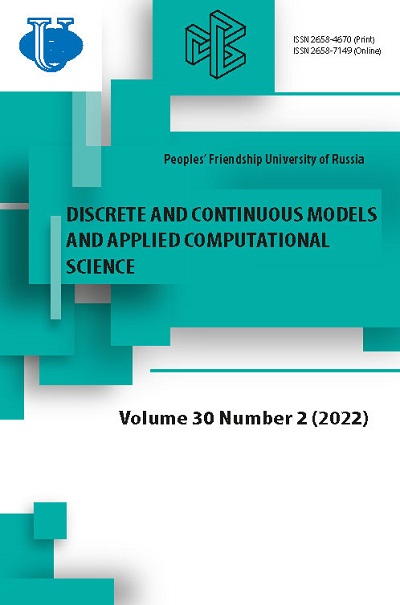Том 30, № 2 (2022)
- Год: 2022
- Статей: 6
- URL: https://journals.rudn.ru/miph/issue/view/1543
- DOI: https://doi.org/10.22363/2658-4670-2022-30-2
Весь выпуск
Численное решение задач Коши со множественными полюсами целого порядка
Аннотация
Рассмотрена задачи Коши для обыкновенного дифференциального уравнения с решением, обладающим последовательностью кратных полюсов целого порядка. Предложен обобщённый метод обратной функции, который сводит вычисление кратного полюса к расчёту простого нуля соответственно выбранной функции. Преимущества такого подхода проиллюстрированы на численных примерах. Предложены сложные тестовые задачи, которые представляют интерес для проверки других численных методов для задач с полюсами.
 105-114
105-114


Оптимизация изотропной метаповерхности на подложке
Аннотация
Впервые приведена математическая формулировка одноволнового безотражательного покрытия на основе двумерного метаматериала. Найдены ограничения на геометрические параметры конструкции. Предложена штрафная функция, которая обеспечивает применимость физической модели и обеспечивает единственность искомого минимума. В качестве примера рассмотрена оптимизация метаповерхности, состоящей из сфер PbTe, расположенных на германиевой подложке. Показано, что точность минимизации с правильно выбранным штрафным термином такая же, как и для целевой функции без него.
 115-126
115-126


Многостадийный псевдоспектральный метод (метод коллокаций) приближенного решения обыкновенного дифференциального уравнения первого порядка
Аннотация
Рассмотрен классический псевдоспектральный метод коллокации, основанный на разложении решения по базису из полиномов Чебышева. Новый подход к формированию систем линейных алгебраических уравнений для решения обыкновенных дифференциальных уравнений с переменными коэффициентами и с начальными (и/или граничными) условиями позволяет значительно упростить структуру матриц, приводя её к диагональной форме. Решение системы сводится к умножению матрицы значений полиномов Чебышева на выбранной сетке коллокации на вектор значений функции, описывающей заданную производную в точках коллокации. Следующее за этой операцией умножение полученного вектора на двухдиагональную спектральную «обратную» по отношению к матрице дифференцирования Чебышева приводит к получению всех коэффициентов разложения искомого решения за исключением первого. Этот первый коэффициент определяется на втором этапе исходя из заданного начального (и/или граничного) условия. Новизна подхода заключается в том, чтобы сначала выделить класс (множество) функций, удовлетворяющих дифференциальному уравнению, с помощью устойчивого и простого с вычислительной точки зрения метода интерполяции (коллокации) производной будущего решения. Затем рассчитать коэффициенты (кроме первого) разложения будущего решения по вычисленным коэффициентам разложения производной с помощью матрицы интегрирования. И лишь после этого выделять из этого множества решений те, которые соответствуют заданным начальным условиям.
 127-138
127-138


Комплексные собственные значения в квантовой механике Курышкина-Вудкевича
Аннотация
Рассматривается одна из возможных версий квантовой механики, известная как квантовая механика Курышкина–Вудкевича. В этой версии существует положительная квантовая функция распределения, но, в расплату за это, правило квантования фон Неймана заменено более сложным правилом, при котором наблюдаемой величине ставится в соответствие псевдодифференциальный оператор . Эта версия представляет собой пример диссипативной квантовой системы и поэтому ожидалось, что собственные значения гамильтониана должны иметь мнимые части. Однако точечный спектр гамильтониана водородоподобного атома в этой теории оказался вещественным. В настоящей статье мы предлагаем следующее объяснение этого парадокса. Традиционно принимают, что в некотором состоянии величина равна , если — собственная функция оператора . При этом дисперсия равна нулю в стандартной версии квантовой механике, но не равна нулю в механике Курышкина. Поэтому можно рассмотреть такой спектр значений и соответствующих им состояний, при которых дисперсия равна нулю. В статье исследован спектр квадратичного пучка методами теории возмущений в предположении малости дисперсии наблюдаемой . Показано, что в окрестности вещественного собственного значения оператора , имеется два собственных значения операторного пучка, которые в первом порядке теории возмущений различаются на величину .
 139-148
139-148


Исследование модели адиабатических волноводных мод для плавно-нерегулярных интегрально-оптических волноводов
Аннотация
Проведено исследование модели адиабатических волноводных мод плавно-нерегулярного интегрально-оптического волновода. В модели явно учтена зависимость от быстропеременной поперечной координаты и от медленно-переменных горизонтальных координат. Сформулированы уравнения для напряженностей полей АВМ в приближениях нулевого и первого порядка малости. Вклады первого порядка малости вносят в выражения электромагнитных полей АВМ деполяризацию и комлекснозначность, т.е. характерные черты вытекающих мод. Предложен устойчивый метод вычисления вертикального распределения электромагнитного поля направляемых мод регулярных многослойных волноводов, в том числе с переменным числом слоев. Описан устойчивый метод решения нелинейного уравнения в частных производных первого порядка (дисперсионного уравнения) для профиля толщины плавнонерегулярного интегрально-оптического волновода в моделях адиабатических волноводных мод нулевого и первого порядков малости. Описаны устойчивые регуляризованные методы вычисления напряженностей полей АВМ в зависимости от вертикальных и горизонтальных координат. В рамках перечисленных матричных моделей используются одинаковые методы и алгоритмы приближенного решения задач, возникающих в этих моделях. Предложена верификация приближенных решений моделей адиабатических волноводных мод первого и нулевого порядков; проведено сравнение их с результатами других авторов, полученных при исследовании более грубых моделей.
 149-159
149-159


Анализ систем массового обслуживания с пороговым механизмом обновления и инверсионной дисциплиной обслуживания
Аннотация
В работе представлено исследование трёх систем массового обслуживания с пороговым механизмом обновления и инверсионной дисциплиной обслуживания. В модели первого типа пороговое значение отвечает только за активацию механизма обновления - механизма вероятностного сброса заявок. Во второй модели пороговое значение не только включает механизм обновления, но и определяет в накопителе границы области, из которой поступившие в систему заявки не могут быть сброшены. В модели третьего типа, обобщающей предыдущие две модели, используются два пороговых значения: одно для активации механизма сброса заявок, второе - для задания безопасной зоны в накопителе. На основе полученных ранее результатов представлены основные вероятностновременные характеристики рассмотренных моделей. С помощью имитационного моделирования проведён анализ и сравнение поведения изученных моделей.
 160-182
160-182
















